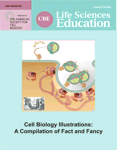Hello Old Friend, My How You've Changed!
The third edition of Essential Cell Biology (ECB), written by Bruce Alberts, Dennis Bray, Karen Hopkin, Alexander Johnson, Julian Lewis, Martin Raff, Keith Roberts, and Peter Walter, nicely updates an established textbook used primarily in undergraduate biology education. It can be used for a stand alone, one-semester course, or integrated into a multi-course system. ECB is generally known as a lighter, less detailed, more approachable version of the authors' Molecular Biology of the Cell, an expansive text designed for graduate and professional school courses in cell biology.
Instructors who have used the second edition of this textbook will feel very comfortable adopting the new edition. The fundamental order and presentation of the material remains unchanged from the previous edition. Each chapter ends with a section on Essential Concepts, useful for instructor review and student self-study. Key features of previous editions, including the breakout “How We Know” sections and the question boxes found in the margins of the text and at the end of each chapter, remain an integral part of the third edition. The answers to those questions are again collected in a separate appendix at the end of the textbook. Also retained in the new edition is the glossary, an especially useful feature for the undergraduate audience. Most importantly, the language and terminology used by the authors remain focused at a level appropriate to and accessible by undergraduate students. The authors continue to manage to convey detailed information to the audience without appearing to condescend to the less experienced scholar.
The major updates to the new edition of ECB are found in Chapters 18–20. The authors have completely revised the chapters on “Cell Cycle Control and Cell Death” and “Cell Division,” merging the two into one new chapter, now numbered Chapter 18 and entitled “The Cell Division Cycle.” This new chapter seems to have a more natural flow and more efficiently presents material on topics such as the cell-cycle control system, mitosis, cytokinesis, and apoptosis. Similarly, Chapter 19, entitled “Sex and Genetics,” has a sharper focus and contains updated information on single nucleotide polymorphisms. Chapter 20, entitled “Cellular Communities: Tissues, Stem Cells, and Cancer,” has been revised and streamlined as well, and now includes sections on the use of stem cells in new clinical treatments and on the therapeutic cloning of embryonic stem cells.

Additional updates, revisions, and refinements are found throughout all portions of the third edition. Chapter 8, “Control of Gene Expression,” contains new information on chromosome structure, epigenetics, microRNAs, and RNAi, the cellular mechanism now widely in use as an experimental tool. The information in Chapter 4, “Protein Structure and Function,” has been reordered, and a new section on how proteins are studied is included. Many of the figures in the third edition of ECB now include color versions of the black and white micrographs found in the second edition. These updated images enhance and refresh the presentation of the figures. The revisions to Chapter 17, “The Cytoskeleton,” include Panel 17–1, which is especially well done. This panel displays images generated from a variety of imaging techniques, and clearly illustrates the characteristics of the three major cytoskeletal protein families.
The instructor resources available with the third edition have also been revised and expanded. Gone are the overhead transparencies, reflecting the pedagogical transition to PowerPoint presentations in the classroom. Figure-integrated lecture outlines are provided as an option for those instructors who want to jumpstart course revisions. There has also been a change in format from CD-ROM to media DVD-ROM. This format change allows for the inclusion of ECB Interactive, which contains animations, video clips, molecular structures, high-resolution micrographs, and other supplemental features not found in the textbook; a media guide; a movie vault; and student self-quizzes. Both the movies and the student quizzes can be readily and easily incorporated into lectures. The Art of ECB is included on the DVD-ROM, and remains a valuable resource, especially for those instructors who prefer to prepare their own PowerPoint presentations. It includes most of the images, tables, and panels from the textbook. Because the images are not linked to or contained within an established PowerPoint presentation, they can be easily added to an instructor's own lecture presentation. Another nice feature is the access to Classwire, an online interactive website provided and managed by Garland Science. Finally, the test bank has been revised and updated as a question bank.
College and university professors who have used the previous editions of ECB will be pleased with the new edition. The format and organization are retained but have been infused with fresh images and updated material. It's as if a trusted old friend has come back from an extended vacation with a bright new look and a refreshed attitude. The reader is at once comfortable with and excited by the changes. New users of this textbook will find it accessible and approachable at the professorial and student levels. The instructor resources remain a valuable addition, especially for those at community colleges or primarily undergraduate institutions—places where access to resources may be more limited. Overall, Essential Cell Biology remains an excellent choice among cell biology textbooks for the undergraduate classroom. I highly recommend it to all CBE—Life Sciences Education readers who are also classroom educators.



